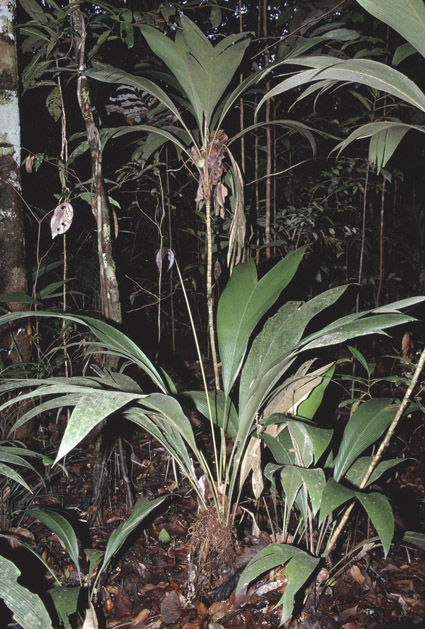- Acanthophoenix
- Acrocomia
- Actinokentia
- Actinorhytis
- Adonidia
- Aiphanes
- Allagoptera
- Ammandra
- Aphandra
- Archontophoenix
- Areca
- Arenga
- Asterogyne
- Astrocaryum
- Attalea
- Bactris
- Balaka
- Barcella
- Basselinia
- Beccariophoenix
- Bismarckia
- Borassodendron
- Borassus
- Brassiophoenix
- Burretiokentia
- Butia
- Calamus
- Calyptrocalyx
- Calyptrogyne
- Calyptronoma
- Carpentaria
- Carpoxylon
- Caryota
- Ceratolobus
- Ceroxylon
- Chamaedorea
- Chamaerops
- Chambeyronia
- Chelyocarpus
- Chuniophoenix
- Clinosperma
- Coccothrinax
- Cocos
- Corypha
- Cryosophila
- Cyphokentia
- Cyphophoenix
- Cyphosperma
- Daemonorops
- Deckenia
- Desmoncus
- Dictyocaryum
- Drymophloeus
- Dypsis
- Elaeis
- Eleiodoxa
- Eremospatha
- Eugeissona
- Euterpe
- Gaussia
- Guihaia
- Hedyscepe
- Hemithrinax
- Howea
- Hyophorbe
- Hyospathe
- Hyphaene
- Iriartea
- Iriartella
- Itaya
- Jailoloa
- Johannesteijsmannia
- Juania
- Jubaea
- Jubaeopsis
- Kentiopsis
- Kerriodoxa
- Korthalsia
- Laccospadix
- Laccosperma
- Lanonia
- Latania
- Lemurophoenix
- Leopoldinia
- Lepidocaryum
- Lepidorrhachis
- Leucothrinax
- Licuala
- Linospadix
- Livistona
- Lodoicea
- Lytocaryum
- Manicaria
- Manjekia
- Marojejya
- Masoala
- Mauritia
- Mauritiella
- Maxburretia
- Medemia
- Metroxylon
- Myrialepis
- Nannorrhops
- Nenga
- Neonicholsonia
- Neoveitchia
- Nephrosperma
- Normanbya
- Nypa
- Oenocarpus
- Oncocalamus
- Oncosperma
- Orania
- Oraniopsis
- Parajubaea
- Pelagodoxa
- Phoenicophorium
- Phoenix
- Pholidocarpus
- Pholidostachys
- Physokentia
- Phytelephas
- Pigafetta
- Pinanga
- Plectocomia
- Plectocomiopsis
- Podococcus
- Pogonotium
- Ponapea
- Prestoea
- Pseudophoenix
- Ptychococcus
- Ptychosperma
- Raphia
- Ravenea
- Reinhardtia
- Retispatha
- Rhapidophyllum
- Rhapis
- Rhopalostylis
- Roscheria
- Roystonea
- Sabal
- Sabinaria
- Salacca
- Saribus
- Satakentia
- Satranala
- Schippia
- Sclerosperma
- Socratea
- Solfia
- Sommieria
- Syagrus
- Synechanthus
- Tahina
- Tectiphiala
- Thrinax
- Trachycarpus
- Trithrinax
- Veitchia
- Verschaffeltia
- Voanioala
- Wallaceodoxa
- Wallichia
- Welfia
- Wendlandiella
- Wettinia
- Wodyetia
- Zombia
- x Jubautia splendens
- ?? Acoelorrhaphe
- ?? Bentinckia
- ?? Brahea
- ?? Clinostigma
- ?? Colpothrinax
- ?? Copernicia
- ?? Cyrtostachys
- ?? Dictyosperma
- ?? Dransfieldia
- ?? Heterospathe
- ?? Hydriastele
- ?? Iguanura
- ?? Incertae sedis & excluded names
- ?? Loxococcus
- ?? Micronoma
- ?? Paripon
- ?? Pritchardia
- ?? Rhopaloblaste
- ?? Serenoa
- ?? Washingtonia

Distribution
From 6°50'N-7°47'S and 45°30'-66°45'W in the central and northeastern Amazon region of Brazil, the Guianas, and Venezuela at 192(7-725) m elevation in lowland rainforest. Galeano and Bernal (2010) report this species from extreme eastern Colombia in Amazonas and Guainía.
(Henderson, A.J. (2011) A revision of Geonoma. Phytotaxa 17: 1-271.)A
(Henderson, A.J. (2011) A revision of Geonoma. Phytotaxa 17: 1-271.)A
Discussion
- Taxonomic notes: Geonoma baculifera is closely related to G. congesta and G. calyptrogynoidea. These three species all have the staminodial tubes of non-fertilized pistillate flowers projecting and persistent after anthesis. Geonoma baculifera differs from its two relatives in its rachillae surfaces with faint to pronounced, short, transverse ridges, and fruit surfaces without fibers emerging.
Subspecific variation: Two traits (stem branching, leaf division) vary within this species. There is no evidence of geographic discontinuity, although there are a few outlying specimens from the central Amazon region. (Henderson, A.J. (2011) A revision of Geonoma. Phytotaxa 17: 1-271.)A
Description
- Plants 2.3 (0.5-6.0) m tall; stems 1.6 (1.0-2.5) m tall, 1.6 (1.3-2.3) cm in diameter, solitary or clustered, canelike; internodes 4.1 (1.4-9.3) cm long, yellowish and smooth. Leaves 9 (6-11) per stem, undivided or irregularly pinnate, not plicate, bases of blades running diagonally into the rachis; sheaths 17.7 (11.0-30.0) cm long; petioles 18.0 (6.5-30.0) cm long, drying green or yellowish; rachis 56.2 (39.5?80.0) cm long, 4.2 (2.6-7.2) mm in diameter; veins raised and rectangular in cross-section adaxially; pinnae 2 (1-10) per side of rachis; basal pinna 55.4 (42.0-76.0) cm long, 17.2(6.7-33.0) cm wide, forming an angle of 20 (12-28)° with the rachis; apical pinna 28.8(14.0-39.5) cm long, 19.5(12.5-40.0) cm wide, forming an angle of 25 (20-35)° with the rachis. Inflorescences branched 1-2 orders; prophylls and peduncular bracts not ribbed with elongate, unbranched fibers, flattened, persistent; prophylls 24.2 (12.7-33.0) cm long, not short and asymmetrically apiculate, the surfaces ridged with close, equal, parallel, non-dividing ridges, scarcely tomentose between the ridges, without unequally wide ridges; peduncular bracts 23.6 (13.5-31.0) cm long, well-developed, inserted 2.8(1.2-7.0) cm above the prophyll; peduncles 29.1 (13.3-44.2) cm long, 4.0 (2.1-8.4) mm in diameter; rachillae 6(3-11), 16.7 (4.0-31.0) cm long, 3.2 (2.2-4.3) mm in diameter, the surfaces without spiky, fibrous projections or ridges, drying brown, with faint to pronounced, short, transverse ridges, not filiform and not narrowed between the flower pits; flower pits spirally arranged, glabrous internally; proximal lips without a central notch before anthesis, not recurved after anthesis, not hood-shaped; proximal and distal lips drying the same color as the rachillae, not joined to form a raised cupule, the proximal lip margins overlapping the distal lip margins; distal lips well-developed; staminate and pistillate petals not emergent, not valvate throughout; staminate flowers deciduous after anthesis; stamens 6; thecae diverging at anthesis, inserted almost directly onto the filament apices, the connectives bifid but scarcely developed; anthers short and curled over at anthesis; non-fertilized pistillate flowers persistent after anthesis; staminodial tubes crenulate at the apex, those of non-fertilized flowers projecting and persistent after anthesis; fruits 10.6 (8.2-12.8) mm long, 7.8 (6.1-9.6) mm in diameter, the bases with a prominent, asymmetric stipe, the apices not conical, the surfaces not splitting at maturity, with fibers emerging to give spiny fruits, not bumpy, not apiculate; locular epidermis with operculum, smooth, with pores. (Henderson, A.J. (2011) A revision of Geonoma. Phytotaxa 17: 1-271.)A
- Log in to post comments

